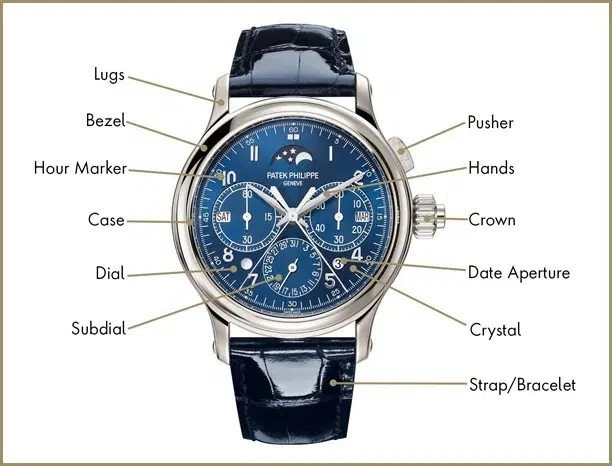Blog about Watches, Jewelry & Bags, Watch Blog
Comprehensive Guide to Watch Anatomy: Understanding the Parts of a Watch
When you delve into the world of watches, you encounter terms that might seem like a foreign language—lugs, crystals, pushers, bezels, and more. Despite their small size, watches are complex devices made up of many components, each playing a crucial role in both function and aesthetics.
Familiarizing yourself with the anatomy of a watch not only enhances your appreciation for these intricate timepieces but also aids in making informed purchasing decisions. In this article, Py-Luxury covers over 20 essential parts of a watch, from the fundamental to the more specialized, ensuring you have a thorough understanding of what makes a wristwatch tick.
1. The Case: The Backbone of a Watch
The case is the foundation of a watch, determining its shape and size. It houses most of the watch’s components and must be robust to endure daily wear and tear.
Modern watch cases are primarily made of stainless steel, though you will also find titanium, resin, and plastic. The size of the case significantly influences how the watch fits and looks on your wrist. Generally, smaller cases suit slender wrists, while larger cases are better for broader wrists. The most common case shapes are round, but you’ll also find rectangular, square, tank, and tonneau shapes.
2. Lugs: The Connectors
Lugs are the extensions that connect the watch case to the strap or bracelet. Positioned at the top and bottom of the case, lugs can be either flat or curved. Curved lugs tend to offer a more comfortable fit by hugging the wrist.
The lug-to-lug distance, which measures the span from the top of one lug to the bottom of the opposite lug, is a key dimension for ensuring a good fit. Longer lugs make a watch appear larger, while shorter lugs give a more compact look.
3. Dial: The Face of the Watch
The dial is the part of the watch that displays the time. It is also the most visually distinctive component, available in various colors, textures, and designs. For example, a guilloche dial features intricate geometric patterns, while a sunburst dial emanates radial lines from the center.
Skeleton dials, which partially or fully expose the watch’s internal mechanism, are particularly eye-catching. These dials offer a glimpse into the intricate workings of the timepiece, making them highly desirable.
4. Subdials: The Multifunction Displays
Subdials are smaller dials located on the main dial, providing additional information such as the date, stopwatch measurements, military time, or different time zones. Chronograph watches often feature two or three subdials for tracking elapsed time, while dress watches might include subdials for the date and day of the week.
5. Crystal: The Protective Glass
The crystal is the transparent cover that protects the dial. There are three main types of watch crystals: sapphire, mineral, and acrylic.
- Sapphire Crystal: Known for its superior scratch resistance, sapphire crystal is almost as hard as diamond. However, it can shatter under severe impact.
- Mineral Crystal: Less scratch-resistant than sapphire but more shatter-resistant, mineral crystal is common in affordable watches.
- Acrylic Glass: The most affordable option, acrylic glass scratches easily but is highly shatterproof and can be polished to remove scratches.
6. Bezel: The Functional Frame
The bezel is the ring surrounding the crystal, securing it to the case. Bezels can be plain or functional, with various markings and designs. Some common types include:
- Diving Bezel: Features a 60-minute scale for tracking elapsed time underwater.
- GMT Bezel: Has a 24-hour scale for tracking a second time zone.
- Tachymeter Bezel: Used to measure speed based on travel time.
7. Crown: The Control Knob
The crown is a small knob typically located on the right side of the case. It is used to set the time and date, wind mechanical watches, and operate other functions. Crowns can be pull-out or screw-down, with the latter providing better water resistance for dive watches.
8. Pushers: The Stopwatch Operators
Pushers are buttons located on either side of the crown. They are used to start, stop, and reset the chronograph function on watches with a stopwatch feature.
9. Signature: The Brand Mark
Every watch features a signature, which is the brand’s name usually displayed on the dial. Additional information such as the watch collection name or water resistance rating may also be included.
10. Hour Markers: Time Indicators
Hour markers indicate the hours on the dial, using indices, Arabic numerals, or Roman numerals. Dress watches often use numerals, while dive watches typically feature luminous indices for better visibility underwater.
11. Hands: The Time Tellers
Watch hands indicate the time and usually include hour, minute, and second hands. They come in various designs, such as Breguet, Dauphine, sword, and spade-shaped. The movement of the second hand is particularly notable: quartz watches move in one-second steps, while mechanical watches have a smoother, sweeping motion.
12. Band/Strap/Bracelet: The Wrist Attachment
The band, strap, or bracelet secures the watch to your wrist. Common materials include stainless steel, leather, rubber, and nylon. Metal bands are often referred to as bracelets. Each material has its pros and cons, such as stainless steel being suitable for water activities and leather being ideal for formal wear.
13. Buckle/Clasp: The Fastener
The buckle or clasp secures the band on your wrist. The two most common types are tang buckles, similar to belt buckles, and deployant clasps, which provide a more secure and adjustable fit. Deployant clasps are often preferred for their ease of use and added security.
14. Links: Adjustable Components
Links are individual segments of a metal bracelet. They can be added or removed to adjust the bracelet’s length for a perfect fit.
15. Pins: The Connectors
Pins are small metal rods that secure the band to the lugs. They are typically hidden inside the band and provide a secure attachment.
Back of the Watch and Additional Features
Helium Release Valve: For Deep-Sea Diving
Professional dive watches often feature a helium release valve to release gases that accumulate during deep-sea dives. This valve prevents damage to the watch when resurfacing.
Luminosity: Glowing in the Dark
Luminosity is crucial for visibility in low-light conditions. Dive, pilot, racing, and military watches often feature luminous markers and hands. Some watches use tritium tubes, which glow continuously without needing an external light source.
Perpetual Calendar: Accurate Date Display
A perpetual calendar accounts for the varying lengths of months and leap years, providing an accurate date display without the need for frequent adjustments.
Moon Phase: Tracking Lunar Cycles
The moon phase feature shows the current phase of the moon. Often displayed in a subdial, this complication adds an element of sophistication to the watch.
Power Reserve Indicator: Monitoring Energy Levels
The power reserve indicator shows the remaining energy in a mechanical or solar watch. It can be a subdial or a simple light that alerts you when the watch needs winding or charging.
Exhibition Caseback: A Peek Inside
An exhibition caseback is a transparent caseback that allows you to see the watch’s movement. It is typically made of sapphire or mineral crystal and adds a touch of elegance by showcasing the intricate mechanics.
Movement: The Heart of the Watch
The movement, or caliber, is the mechanism that powers the watch. Automatic movements use the wearer’s natural motions to generate power, while quartz, solar, and kinetic movements rely on batteries or solar cells. An automatic movement can consist of over a hundred parts, making it a marvel of engineering.
Rotor: The Power Generator
In automatic watches, the rotor is a semicircular weight that spins with the motion of your wrist. It winds the mainspring, providing the energy needed to power the watch.
Jewels: Reducing Friction
Jewels are synthetic ruby or sapphire bearings used in the movement to reduce friction between moving parts. More complex movements with additional complications typically have a higher number of jewels.
Final Thoughts
Understanding the parts of a watch enhances your appreciation for these intricate timepieces and helps you make informed decisions when purchasing or discussing watches. Each component, from the case to the movement, plays a vital role in the watch’s functionality and aesthetics. Armed with this knowledge, you can confidently navigate the world of watches and even impress others with your expertise.
Read more: All our experience and knowledge about watches

